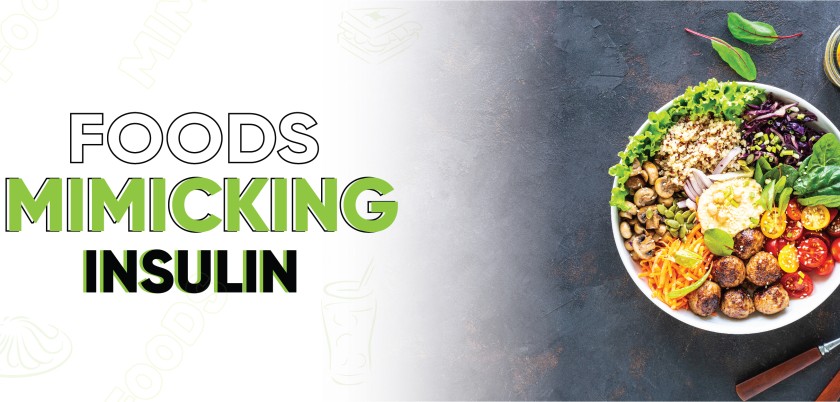
Natural insulin sensitisers and insulin mimetics
Pancreas, an endocrine gland, produces a hormone named insulin which controls the blood sugar levels. Beta cells of the pancreas are responsible for the release of this hormone, which when damaged result in diabetes. Nature has given us some foods that normally boost the secretion of this hormone or mimic the role of this hormone.
- Red cabbage - The principal antidiabetic bioactive compounds in red cabbage are anthocyanins, flavonoids and glucosinolates. Red cabbage contains betalains which normally increases the insulin production and reduces the blood glucose levels. Moreover this vegetable has a low glycemic index and high fibre content, making it a great food for hyperglycaemia prevention. Consume it raw as salads for maximum benefits and if you don't like it raw, have it cooked as a vegetable or add in dals and soups.
- Lady finger / Okra - This vegetable is loaded with fibre and is low in calories, and also is very nutritional due to the presence of Vitamin B, Vitamin C, folic acid, potassium and calcium in it. Okra is believed to decrease the blood sugar levels in type1, type 2 and gestational diabetes. Okra seeds contain alpha glucosidase inhibitors that prevent the conversion of carbohydrates to glucose, thereby maintaining blood sugar levels. Its fibre content slows down the absorption of glucose from the intestinal tract. Okra juice has shown to aid in glucose management and insulin secretion. Cut 3-4 medium sized okra in 4 parts and keep them in a jar with 1-1.5 litres of water. After 8-24 hours, squeeze out the ladyfingers to remove all its extract and drink this on an empty stomach to avail health benefits.
- Bitter gourd - This vegetable is a boon for diabetics. It contains some substances namely charantin, vicine and polypeptide-P, which increase the production of insulin from the pancreas. Polypeptide P or P-insulin works by mimicking the action of human insulin in the body and this may be used as plant-based insulin replacement in patients with type-1 diabetes. Consume the juice of this vegetable with gooseberry juice ('amla') to get the maximum benefits as both aim to stimulate the beta cells of the pancreas to release insulin for glucose management.
- Insulin plant (Jarul) - This plant, commonly grown in South India, as the name suggests, functions to increase insulin secretion by the beta cells of the pancreas. Hyperglycaemia episodes are prevented due to the presence of corosolic acid in the leaves of this plant that promote insulin secretion. Chew one to two leaves of this plant early morning to control fasting blood sugar and postprandial sugar levels. Another way to use this plant is to wash and dry the leaves, then grind it into powder. One tablespoon (10-15 g) of this powder can be consumed daily. The catchphrase of this plant is 'a leaf a day keeps diabetes away'.
- Turmeric - This commonly used spice contains curcumin which is responsible for activation of the beta cells of the pancreas to release insulin for blood sugar regulation. This medicinal plant can be used as an alternative medicine for diabetes patients due to its anti hyperglycemic effects. Due to the curcumin's effect of improving overall functioning of beta cells, it has also shown to reverse prediabetes. Its anti-diabetic effect can also be attributed to anti inflammatory effect of curcumin, that leads to diabetes. Ways to incorporate turmeric in diet in addition to its use as a spice in curries and vegetables, is having turmeric milk at bed time. Also add gooseberry juice, ginger powder, cinnamon powder or black pepper in turmeric milk for enhancing the benefits.
- Fenugreek seeds - One of the most important superfood for diabetes patients is fenugreek seeds or 'methi dana'. A plant alkaloid called trigonelline and 4-hydroxyisoleucine amino acid are responsible for raising the insulin sensitivity and insulin production in hyperglycemia respectively in diabetics. Fibre content in these seeds (galactomannan) slows down the absorption of carbohydrates in the body, thereby preventing sudden blood glucose shoot ups. Research has also shown these seeds to possess insulinotropic effects, which leads to lower blood sugar levels. Use these seeds by soaking them in water overnight and drinking on an empty stomach or making a powder of these seeds and adding a teaspoon to hot water and drinking it. Sprouted fenugreek seeds can also be used in salads, stuffed paranthas, khichdi or in south Indian dishes' batter such as idli and dosa. Another way to consume them is roasting them on medium high heat and adding a teaspoon to curries, stir-fry vegetables and salads. Fenugreek tea is also a good alternative for addition of these wonder seeds in the diet.
- Cinnamon - This barky spice increases the body's cells sensitivity to insulin and also enhance the secretion of insulin. This spice is known for imitating the effects of insulin. The effects are not only immediate but sustain for 12 hours. Have a cup of tea with added cinnamon to it or cinnamon water. Powdered spice can also be sprinkled on the meals.
- Aloe vera - Its an important herb gaining popularity due to its medicinal properties especially anti diabetic effects. Juice or gel of this plant regulates the insulin levels in the body and prevents blood glucose shoot ups. Impaired blood glucose levels in pre diabetics have been improved by the intake of aloe vera extract.
Living with diabetes is challenging and it can take time to find the best combination of oral hypoglycaemic drugs and diet that works the best for you. Avoiding hyperglycemic episodes is very important for a diabetic to avoid complications and for this having a balanced low carbohydrate and high fibre diet with natural foods that mimic the role of insulin or raise the insulin levels in the body is very important.






